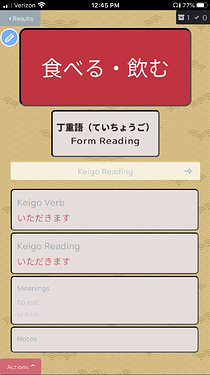This is my very first public set! It is centered around memorizing 敬語, since that is something I have a lot of trouble with. I’m a bit nervous since this subject is a bit hard to understand and I don’t want to mislead people, but I’m confident that I have gathered up a sufficient explanation and everything in the set so far is properly categorized.
Any feedback is appreciated!
Latest Update:
- Added some conjugation rules for 丁重語 and 尊敬語
- Added the first example sentence
====================
What is Keigo 敬語?
I’m not an expert in 敬語, but I will try my best to explain it here using my resources and knowledge:
In short, Keigo is a respectful and more formal set of words and conjugations generally used to show respect: in the workplace, to older people, to people of higher standing, to otherwise remarkable people, and so on.
Keigo has three/four categories:
丁寧語 (ていねいご): Teineigo refers to the ます (masu) form as well as the other standard “polite” words, like です (desu). While this is considered a form of Keigo, according to my sources it is not considered quite as polite as the other Keigo. Because this form is regular and you will no doubt find Teineigo conjugations very early on without this set, I have decided not to include them in the set.
丁重語 (ていちょうご): In English, this is referred to as the courteous form. It seems that the courteous form is less often discussed and sometimes is completely looked over. What is important is that the courteous form shows respect to the listener or third person when talking about the speaker’s own action or state not including the listener or third person, and when introducing oneself
尊敬語 (そんけいご): In English, this is referred to as the honorific form. The honorific form shows respect to the listener or third person when talking about their state/actions.
謙譲語 (けんじょうご): In English, this is referred to as the humble form. The humble form shows respect to the listener or 3rd person when talking about the speaker’s own actions that involves the listener/third party
Why study Keigo with this set?
Generally when you’re studying a word, you learn the kanji, pronunciation, and meanings. However, with Keigo words, it is also important to know the category as they have different uses (described above). This set will make sure that you know that category for each special Keigo verb. Of course, it will also make sure you know the special verb pronunciations and what casual verbs they correspond to!
How will this set be changing/updating in the future?
- Will be adding voice recordings from Forvo for 敬語.
- Considering adding grammar information in a know/don’t know format.
- Considering adding a third format where you are given a 敬語 term and must choose which category it is, or something of the sort.



 . I was going to report because I had to keep switching between Eng / Jp keyboards. I didn’t check today, couple of days ago it could not accept kanji readings even though they were in the answer (not sure if this changed but if I don’t need to switch keyboards, this is probably not an issue).
. I was going to report because I had to keep switching between Eng / Jp keyboards. I didn’t check today, couple of days ago it could not accept kanji readings even though they were in the answer (not sure if this changed but if I don’t need to switch keyboards, this is probably not an issue).



 But I’ll keep on trying to figure out how I might add something like that. For now, there are descriptions at the top of this page, and there are a small amount of example sentences with explanations in the note about why they are used.
But I’ll keep on trying to figure out how I might add something like that. For now, there are descriptions at the top of this page, and there are a small amount of example sentences with explanations in the note about why they are used.